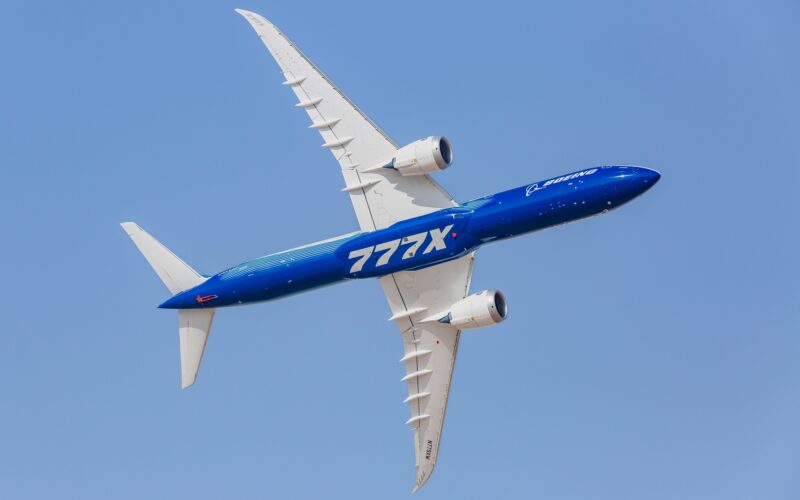Boeing has changed the technical specifications of the 777X-8, stretching the aircraft, which has in turn increased its passenger capacity and range.
Currently, Boeing’s product page for the 777X aircraft family, which includes both the 777X-8 and 777X-9, shows that the 777X-8 seats 395 passengers in a typical two-class configuration, flying up to 8,745 nautical miles (16,190 kilometers). The length of the aircraft is 232 feet and 6 inches (70.86 meters).
Previously, the page showed that the 777X-8 typically seated 384 passengers, flying up to 8,730 NM (16,170 km), with the length of the aircraft being 229 ft (69.79 m).
Looking at data from Wayback Machine, the 777X’s product page still showed the former configuration as of May 28, 2023. By June 2, 2023, the specifications of the 777X-8 had changed, with the exception of the length of the aircraft, which Boeing modified sometime in January 2023, Wayback Machine archives indicate.
By December 31, 2022, the length of the smaller 777X aircraft was still given as 229 ft (69.79 m).
The change was first noticed by Max Kingsley-Jones, a Senior Consultant at Cirium.
In comparison, the larger 777X-9 can typically seat 426 passengers in a two-class configuration, flying up to 7,285 NM (13,500 km). It is almost 20 feet longer than the 777X-8, measuring 251 ft 9 in (76.72 m).
Boeing struggling to sell the 777X-8
However, Boeing has struggled to sell the passenger version of the 777X-8. Out of the 383 total commitments, only 24 are for the 777X-8, with Emirates ordering 16, while fellow United Arab Emirates (UAE) airline Etihad Airways has committed to eight aircraft of the type, according to ch-aviation.com data.
But in June 2023, Emirates ordered 16 777X aircraft, according to Boeing’s Orders & Deliveries filings for the month, prompting speculation that the airline had scaled up its order to the 777X-9. In total, there were 318 firm orders for the 777X, according to Boeing’s orders data as of June 30, 2023.
At the International Air Transport Association (IATA) Annual General Meeting (AGM) in June 2023, Emirates President Tim Clark told Aviation Week that he was “irritated” that Boeing had delayed the introduction of the type, with it now being scheduled to come after the 777X-8F, the freighter version of the 777X-8. However, Clark still said that the twin-aisle jet would be a “very good aircraft”.
In a statement to Air Insight at the time, an Emirates spokesperson said only that the airline was committed to 115 aircraft of the type, without specifying the split between the 777X-8 and 777X-9.
If Emirates did switch up its order book, that would mean that there are only eight orders for the passenger version of the 777X-8 remaining. Meanwhile, there are 55 orders for the 777X-8F and 304 orders for the 777X-9.
When Boeing announced its Q2 2023 results, the manufacturer’s Securities and Exchange Commission (SEC) filing said that it expects the first delivery of the 777X-9 to occur in 2025, whereas the first delivery of the 777X-8F should happen in 2027.
As of June 30, 2023, the plane-maker has booked a total of $587 million of abnormal costs related to the 777X program, anticipating that the total abnormal costs bill would be around $1 billion until the production of the aircraft type resumes later in 2023. Previously, Boeing had planned to resume production of the 777X in 2024.
David Calhoun, the President and Chief Executive Officer (CEO) of Boeing, said there has not been any additional progress with the Federal Aviation Administration’s (FAA) certification of the 777X, but the plane-maker wants to “simply get ahead of the production curve” during the Q2 2023 results call.
AeroTime approached Emirates for comment.

